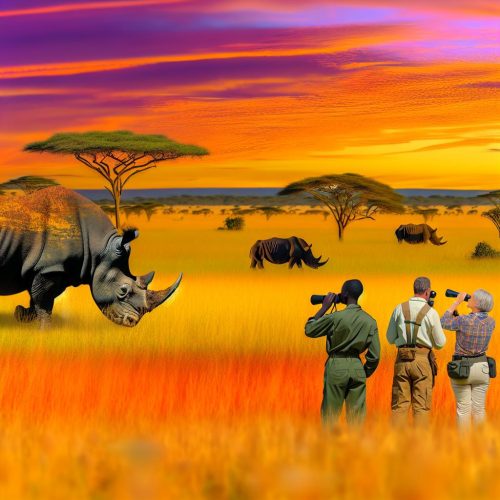Introduction to Rhino Tracking Safaris
Embarking on a rhino tracking safari provides a unique opportunity to observe these magnificent creatures in their natural habitats. These safaris are organized in various parts of Africa, offering visitors a chance to learn about conservation efforts while experiencing the thrill of tracking one of the Big Five.
Rhino Species on Safari
There are two primary species of rhinos often encountered on these safaris: the white rhino and the black rhino. Both species are unique, with physical and behavioral differences. Understanding these differences enhances the safari experience and provides insight into their survival strategies.
White Rhino
The white rhino is distinguished by its wide mouth, adapted for grazing. This species is generally larger and less aggressive than its black counterparts, making them easier to track in certain regions. White rhinos tend to be more social, often found in groups called “crashes.” Their generally docile nature allows for closer observation under guided supervision.
Black Rhino
Known for their hooked lip, black rhinos are primarily browsers and feed on bushes and trees. They are usually solitary animals, which, combined with their preference for dense bush, makes them more elusive. Tracking black rhinos requires experienced guides who are adept at navigating these more challenging environments. The thrill of spotting a black rhino is heightened by the skill and patience required.
Tracking Techniques
Tracking rhinos in the wild typically involves a combination of skills and technology. Guides utilize traditional tracking techniques, such as reading spoor (tracks) on the ground, along with modern tools like GPS for monitoring.
Guided Walks
Guided walks are a central component of rhino safaris, allowing visitors to closely observe the rhinos while maintaining a safe distance. Experienced guides provide insights into the animals’ behavior and the surrounding ecosystem. Walking safaris enable visitors to engage more directly with the environment compared to vehicle-based tours, offering a more intimate understanding of the landscapes these animals inhabit.
Conservation and Education
Many safaris are conducted in collaboration with conservation organizations focusing on rhino protection efforts. These safaris often contribute to anti-poaching initiatives and provide funding for local conservation projects. Participants can learn about ongoing conservation strategies and the challenges faced in protecting these endangered animals. Through hands-on involvement, such as participating in tracking exercises and learning from local conservationists, safari participants gain a deeper appreciation of the complexities of wildlife conservation.
Popular Destinations
Several regions in Africa are renowned for their rhino tracking safaris. These areas are significant not only because of their rhino populations but also due to their active conservation efforts, which have helped sustain these populations over the years.
South Africa
South Africa hosts a large portion of the continent’s rhino population. Renowned reserves, such as Kruger National Park and Hluhluwe-Imfolozi Park, offer structured safari experiences. These parks are significant not only for their size but also for their conservation histories and the diversity they offer. Many tour operators provide tailored packages that include both rhino viewing and active participation in conservation activities, such as monitoring programs or educational workshops.
Namibia
Namibia presents a unique desert landscape, with regions like Damaraland and Etosha National Park providing the backdrop for tracking rhinos in more arid environments. Namibia’s rhino conservation initiatives are renowned and offer a different context for understanding this species. The stark beauty of the desert creates a captivating setting for safari-goers who can witness rhinos’ adaptation to such harsh conditions firsthand.
Booking and Considerations
When planning a rhino tracking safari, it is essential to research operators and select those that emphasize ethical practices and sustainability. Selecting a reputable provider ensures that safaris are conducted respectfully toward the wildlife and the local communities.
Ethical Practices
Participants should inquire about the operator’s involvement in conservation efforts. Operators that actively support conservation and local communities tend to offer more comprehensive and informative safari experiences. It’s advisable to choose those with strong partnerships with local and international conservation bodies, as well as those that contribute financially to local initiatives.
Travel Tips
Travelers should prepare with appropriate gear for walking safaris, including sturdy shoes, sun protection, and clothing in neutral colors to avoid startling wildlife. Attention to health and safety advice specific to the region being visited is also recommended, ensuring travelers are adequately prepared for the environment and any regional health advisories.
In conclusion, rhino tracking safaris offer an educational and engaging way to participate in wildlife conservation efforts. They provide a thrilling experience while helping to drive awareness and support for the preservation of these iconic animals. By choosing an ethical provider, participants contribute positively to the sustainability of wildlife tourism and conservation initiatives, ensuring that these majestic creatures remain a part of our world for generations to come.
